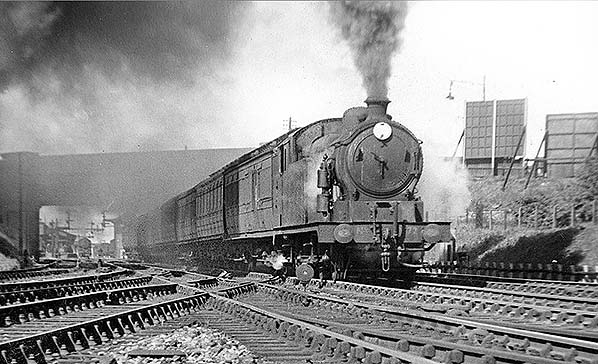
Photo by John Ford from David Ford's Flickr photostream
Information with the above image states the locomotive is N7 0-6-2T 69672 but, through the grime, it appears to be still in LNER livery and carrying an LNER number. The train is a Cambridge - Stratford stopper and appears to comprise a clerestory brake third, an articulated set and a couple of other individual vehicles. At the time of writing, the Stratford service still operates but has been reduced to a couple of morning peak services and an all-day Sunday service calling at all stations except Angel Road and Northumberland Park, unless Tottenham Hotspur are playing at home in which case trains also call at Northumberland Park.
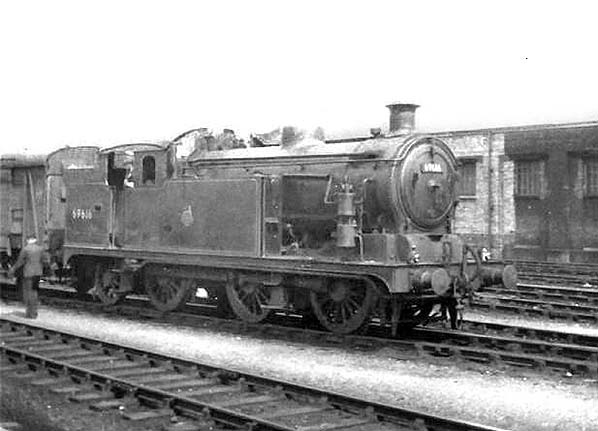
Photo from John Mann collection
Another N7 at Cambridge, above, this time 69616 in September 1951. This example was one of a few of the class allocated to Cambridge at various times, including three for Saffron Walden push-pull services (69651/90/2). This time we can see the full BR livery with the small version of of 'emaciated ferret' logo. This logo also appeared on early Derby Lightweight DMU cars until replaced by the coaching stock roundel version.
 The N7s were a Hill design for Great Eastern Railway London suburban services. Some were fitted with condensing gear but this was later removed by the LNER. The nature of their work required dictated frequent stopping and starting with good acceleration and braking characteristics. The class thus had relatively small 4ft 10in driving wheels and this, when viewing the locomotives from certain angles, gave them a rather odd, dumpy appearance. On the Saffron Walden branch they replaced the ex-North Eastern G5 0-4-4 tanks which had moved to Cambridge from the Palace Gates branch.
The N7s were a Hill design for Great Eastern Railway London suburban services. Some were fitted with condensing gear but this was later removed by the LNER. The nature of their work required dictated frequent stopping and starting with good acceleration and braking characteristics. The class thus had relatively small 4ft 10in driving wheels and this, when viewing the locomotives from certain angles, gave them a rather odd, dumpy appearance. On the Saffron Walden branch they replaced the ex-North Eastern G5 0-4-4 tanks which had moved to Cambridge from the Palace Gates branch.
The Great Northern line had the similar but proportionally neater Gresley N2 0-6-2 tanks. These also appeared at Cambridge but were by no means common. The GNR also had the little-known Ivatt R1 0-8-2 suburban tanks, worth a mention due to a plan to convert them to diesel-compressed air operation. It is probably just as well that this scheme never came into being. The R1s were soon moved to Yorkshire to work coal trains and all were withdrawn during the 1930s.
Of the N2s and N7s, just one of each survived into preservation.
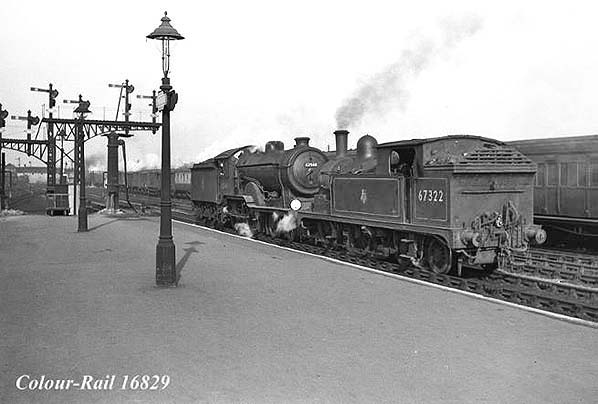
© Colour-Rail
Above is ex NER Class G5 0-4-4T 67322 buffered-up to a D16 opposite platform 4. The date is 4 March 1955. Three of the G5s had moved to Cambridge as mentioned above to work push-pull trains on the Saffron Walden branch. The other two were 67269 and 67279. The usual procedure was to have two at Saffron Walden and one spare, or under maintenance, at Cambridge. Diagrams provided for one engine at a time from Saffron Walden to be changed over, via Bartlow or Audley End, with another ex Cambridge; that returning to Cambridge then undergoing maintenance before returning to Saffron Walden a week or so later to replace another. The G5s had replaced C12 4-4-2T locomotives at Saffron walden and in turn the G5s were replaced by N7s in 1956 before railbuses took over, or tried to, in 1958. The G5s were not popular with Saffron Walden crews; when pushing, the regulator was either fully open or fully closed with no in-between, so crews devised a little get-around by jamming a bolt in the regulator to prevent it opening beyond a certain position. Unfortunately the bolts frequently sheered. When the N7s took over, the G5s were withdrawn and scrapped.
67322 displays the smaller version of the original BR logo, the 'emaciated ferret', while the D16 displays the larger version. Less derogatory names for the logo were the 'lion and wheel' or the 'cycling lion'.
Note the impressive array of lower-quadrant signals and the BR totems on the lamp standard. The story of the Cambridge totems is a peculiar one and we will be covering this later.
The Bulleid Pacifics
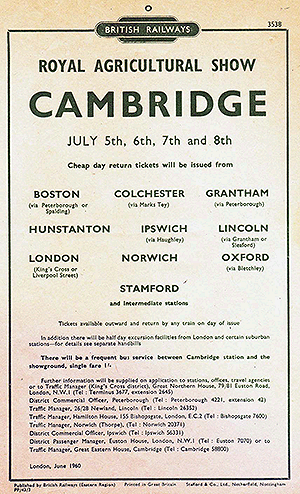 Nothing whatsoever to do with the 1948 locomotive exchanges, in 1949 and again in 1951/2 a number of ex-Southern Railway Bulleid Light Pacifics appeared on what had come to be known as BR Eastern Region's Great Eastern Section (GE), based at Stratford. The reason for this is not entirely clear to this day but there are suspicions; the 1949 trial may have been to test a Pacific type (4-6-2) on the GE ahead of plans to accelerate Liverpool Street - Norwich trains via both Ipswich and Cambridge, while the 1951/2 appearance was probably due to problems with the then newly introduced Britannia Pacifics.
Nothing whatsoever to do with the 1948 locomotive exchanges, in 1949 and again in 1951/2 a number of ex-Southern Railway Bulleid Light Pacifics appeared on what had come to be known as BR Eastern Region's Great Eastern Section (GE), based at Stratford. The reason for this is not entirely clear to this day but there are suspicions; the 1949 trial may have been to test a Pacific type (4-6-2) on the GE ahead of plans to accelerate Liverpool Street - Norwich trains via both Ipswich and Cambridge, while the 1951/2 appearance was probably due to problems with the then newly introduced Britannia Pacifics.
Designed by the unconventional Oliver Bulleid, Chief Mechanical Engineer of the Southern Railway, the West Country and Battle of Britain classes were a lightweight version of the Merchant Navy class. Incorporating a number of unusual, or damn nuisance depending upon one's point of view, features, a brief but to the point description of them can be read here.
The Bulleids were not fitted with water scoops (a device to permit locomotives to pick up water on the move from troughs laid between the rails) and this appears to have caused some problems on the Liverpool Street - Norwich via Ipswich route, so the Bulleid's tended to appear more often on the Cambridge line. The locomotives involved were 34059 'Sir Archibald Sinclair' in 1949 and the same locomotive reappeared in 1951 together with 34039 'Boscastle'; 34057 'Biggin Hill'; 34065 'Hurricane'; 34076 '41 Squadron'; 34089 '602 Squadron'. Of those, 'Boscastle' was a West Country class with the remainder being Battle of Britain class.
Sir Archibald Sinclair, that is, the human version, was leader of the Liberal Party from 1935 to 1945 and Secretary of State for Air during WWII. He had fought in WW1 and was close to Winston Churchill for many years. He personally performed the naming ceremony on the locomotive at Waterloo on 24 February 1948.
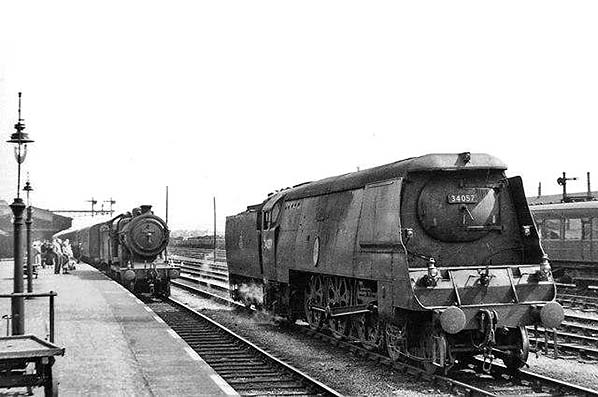
Photo by Ben Brooksbank
Above is 34057 'Biggin Hill' at Cambridge during 1951, thought to be in July. The D16 at the platform does not appear to be coupled to the train behind it so perhaps it has replaced, or is about to be replaced by, the Bulleid. One of the peculiarities of the air-smoothed Bulleids was the smokebox being an integral part of the casing. For obvious reasons, they gained the nickname 'Spamcans'.
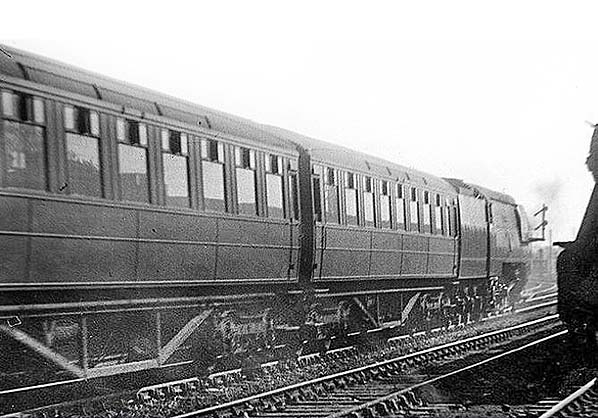
Photo by John Ford from David Ford's Flickr photostream
Above is 34059 'Sir Archibald Sinclair' at Cambridge on a Norwich - Liverpool Street test run in May 1949. Although the photograph is known to have been taken at Cambridge, the precise location is difficult to determine. Information with the photograph states Cambridge South but it appears to be Cambridge North and the train is taking one of the platform avoiding roads.
The 'Spam Cans' were returned to the Southern Region in 1952, presumably once the problems with the Britannias had been sorted out. Many of the Bulleids were rebuilt by BR into conventional form but nevertheless many ran to the end in air smoothed form. The last examples were withdrawn in 1967 and many have survived into preservation. Of those which appeared at Cambridge, 'Boscastle' and 'Sir Archibald Sinclair' have survived and both are in rebuilt form.
The LNER / BR Sentinel Shunters
This topic is placed in the British Railways section due to use of an image from the BR period. All the Big Four railway companies either trialled or purchased these little shunting locomotives with the LNER purchasing a large batch from 1927 onwards. There were two types; Class Y1 and Y3. The Y1 was single speed and the Y3 two speed. The Y1 was intended purely as a shunter but the Y3 was intended, or rather Sentinel promoted it for, shunting, trip work and branch goods traffic but apart from a few trials the Y3s were used exclusively as shunters. Gear changing could only be accomplished when the locomotive was stationary; this meant a lower tractive effort in high gear which in turn seriously limited their usefulness as branch goods locomotives.
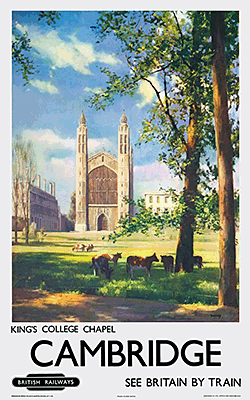 However, at Cambridge the two-speed design of the Y3s was useful when running light or transferring a wagon or two between Chesterton Junction and the engineers siding near Mill Road which involved a run of a couple of miles along the main line.
However, at Cambridge the two-speed design of the Y3s was useful when running light or transferring a wagon or two between Chesterton Junction and the engineers siding near Mill Road which involved a run of a couple of miles along the main line.
A number of these Y1 / Y3 locomotives appeared at Cambridge over the years including Nos 39, 42, 60, 61, 78, 87, 96, 98. The last known sighting at Cambridge was in April 1960, 39, a Y1, being the example noted. 42, a Y3, was the most well known example and seems have spent a long period at Cambridge. The Sentinels went through several numbering schemes over the years, culminating with BR 68xxx series numbers as well as departmental numbers. The numbers given in this paragraph are the numbers carried at the time the locomotives were noted, which was over a long period of time.
Apart from being two-speed, the Y3 had a slightly larger boiler than the Y1 but otherwise the two types were virtually identical. Mechanically they were little more than rail versions of the steam road lorries built by the Sentinel Waggon Works, Shrewsbury. In essence the same vertical water-tube boiler and two-cylinder vertical engine was used with drive to the axles being via roller chain.
The Sentinels offered some advantages over conventional locomotives; steam could be raised from cold to working pressure, which was 275psi, in about one hour and they could be operated by one man. The boiler was mounted in the cab with the chimney exiting through the cab roof; this caused problems during wartime as at night the glow from the firebox was very visible from the air. Reports say that because of this the Sentinels were put into store for the duration although it is quite possible they continued to be used intermittently but only during daylight hours.
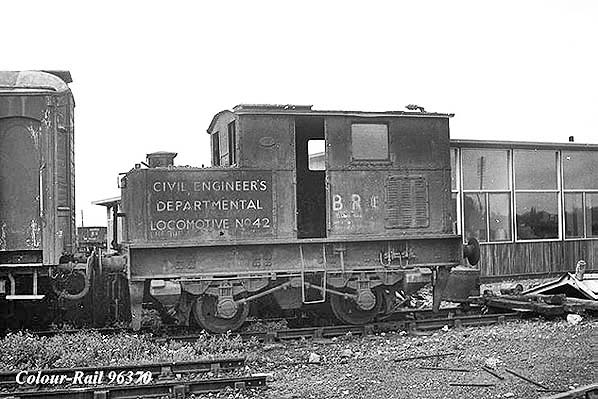
© Colour-Rail
Above can be seen Y3 departmental 42 at Chesterton Junction. 42 is possibly dumped out of use although its scruffy condition is nothing to go by as it was almost always scruffy. There was usually a pair at Chesterton Junction, with one sometimes scooting off for a potter in Mill Road engineers sidings as we have mentioned. At the time .42 was photographed, the other, if indeed another was present, was most likely 39. The date of the above photograph is not known. Photographic evidence tells us 42 was at Chesterton Junction dismantled and under repair during October 1955, while further such evidence tells us it was back in service by summer 1957. The apparently dumped out of use status above, therefore suggests the date might be early 1955. A further photograph exists showing 42 at Mill Road in August 1955.
The fact 42 was dismantled, repaired and reassembled at Chesterton Junction shows another advantage of these little shunters; providing a crane, suitable tools and appropriate know-how were available, they did not require the special facilities demanded of conventional locomotives. This was a big advantage for small industrial users such as Cambridge gasworks.
The layout of the Y1 and Y3 comprised a vertical boiler in the outer end of the cab (on the right in the above image), a 2-cylinder engine in the inner end of the cab and water tank and bunker outside the cab. The water tank filler can be seen above the word 'civil' . The whistle can be seen on the cab roof, above the boiler. The firebox was fed via a hatch in the top of the boiler, this being the usual arrangement with Sentinels although some did have bottom-feed boilers.
The Cambridge gasworks Sentinel (see Part 10) had the usual top-feed boiler in the cab but the engine was mounted at the front of the locomotive, ie in what would be the smokebox position on a conventional locomotive, with a cylindrical water tank between engine and cab.
Despite Sentinels being operable by one man, no form of 'dead man' device was fitted as far as is known.
The Cambridge BR Sentinels were replaced by departmental diesels 81, 91 and 92. 81 was a Barclay 0-4-0 which is said to have stayed only briefly at Cambridge before being sent to Peterborough. 91 and 92 were BR Class 03s and they eventually entered capital stock as D2370/1, later 03370/1.
Of the Sentinels, it will be recalled that Cambridge also witnessed that company's steam railcars on a couple of occasions so with the steam shunters, including that at the gasworks, Cambridge had something of a long association with the name.
The BR Standard Steam Locomotives
These locomotives, which we have already touched upon, were the result of an attempt, largely successful, by BR to take the best features of pre-nationalisation designs and incorporate them into a fleet of various types of standard locomotive. This had been the reason for the 1948 locomotive exchanges but ultimately the BR Standards were based upon existing LMS designs.
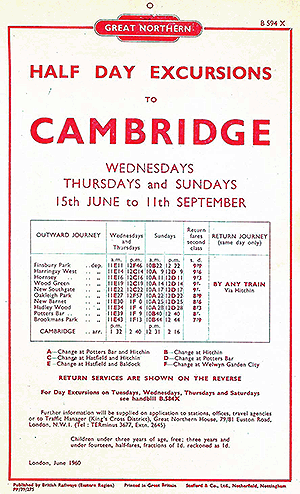 There was a need to replace many worn out and inefficient steam locomotives following WWII and with the railways nationalised in 1948 it made good sense to have some sort of standard fleet. BR was also faced with a labour problem; men were beginning to find cleaner and better paid work in other areas of industry and which did not, to a degree, involve the antisocial hours that railway work did. Today it is hard to visualise the life of the would-be train driver of bygone times. A young recruit of the steam era would be required to start as a cleaner and this involved the filth, grime and a degree of danger within the confines of steam sheds. Eventually the recruit might make the grade of passed cleaner, meaning he was still a cleaner but could act as locomotive fireman when required. The next step up was fireman, then passed fireman which meant he could drive when required to do so. The next step up was to driver but that in itself was not necessarily glamourous; as fireman, he might be working on main line 'top link' jobs but when promoted to driver he may very well find himself back on more mundane goods and local traffic. Depending upon which shed was involved, being promoted to a 'top link' driver took many years and in some cases career railwaymen did not acquire senior status until shortly before retirement. It was for this reason that senior drivers of days gone commanded a justified degree of respect and their knowledge and experience was impossible to describe in any book or film.
There was a need to replace many worn out and inefficient steam locomotives following WWII and with the railways nationalised in 1948 it made good sense to have some sort of standard fleet. BR was also faced with a labour problem; men were beginning to find cleaner and better paid work in other areas of industry and which did not, to a degree, involve the antisocial hours that railway work did. Today it is hard to visualise the life of the would-be train driver of bygone times. A young recruit of the steam era would be required to start as a cleaner and this involved the filth, grime and a degree of danger within the confines of steam sheds. Eventually the recruit might make the grade of passed cleaner, meaning he was still a cleaner but could act as locomotive fireman when required. The next step up was fireman, then passed fireman which meant he could drive when required to do so. The next step up was to driver but that in itself was not necessarily glamourous; as fireman, he might be working on main line 'top link' jobs but when promoted to driver he may very well find himself back on more mundane goods and local traffic. Depending upon which shed was involved, being promoted to a 'top link' driver took many years and in some cases career railwaymen did not acquire senior status until shortly before retirement. It was for this reason that senior drivers of days gone commanded a justified degree of respect and their knowledge and experience was impossible to describe in any book or film.
But while the BR Standard steam locomotives could not do anything about the long climb up the seniority ladder, they were intended to make the jobs of those involved, from cleaners to drivers, somewhat easier and thus help attract new recruits to the railway - or, perhaps, to help persuade further men not to leave railway service. There has also been some suggestion that BR hoped the new Standard locomotives would attract orders from abroad. This was at a time when British heavy industry still manufactured and exported its goods but any such hopes BR had for worthwhile foreign orders for its Standard steam locomotives really came too late. Many years later BR had similar hopes for its Class 58 diesel design but, again, nothing ever came of it.
Among the features incorporated into the Standards were the self-cleaning smokebox, mechanical stokers, automatic lubrication for certain components, rocking (fire) grates, cabs better protected from the weather and a number of other features designed to make life easier. The Standards were generally popular with engine men although men from some regions showed a degree of dislike, probably due to an ingrained allegiance to designs of the former Big Four companies.
Standard steam locomotives ranged from small 2-6-2T types up to the Pacific types (4-6-2) and the mighty 9F 2-10-0 freight locomotives which, as it turned out, were also well capable of working fast passenger trains. There were three Pacific types, the Britannia class, the Clan class and the solitary Class 8 71000 'Duke of Gloucester'. Against all odds, the latter managed to survive into preservation and the story of her restoration is an epic in itself.
Insofar as Cambridge was concerned, several types of BR Standard were commonly seen; the Class 7 Britannia; Class 4 2-6-4T; Class 5 4-6-0; Class 2 2-6-0; Class 9 2-10-0.
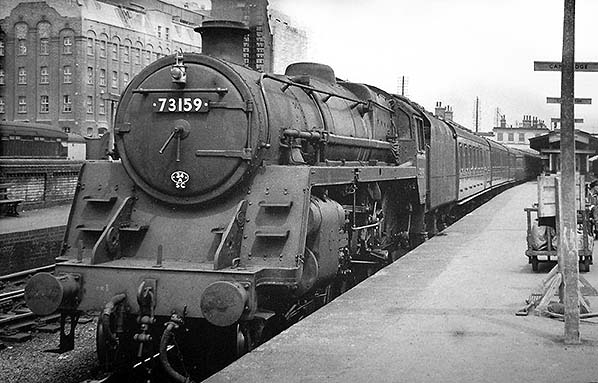
Photo from Rick2E's Flickr photostream
Above a Standard 5 4-6-0 is seen awaiting departure from platform 2 with a stopping service to King's Cross. The 34A shedplate tells us the locomotive was based at King's Cross. A total of 172 of the type were built between 1951 and 1957 and could be seen from the south coast to Scotland, with twenty Southern Regions example taking names with withdrawn King Arthur class locomotives. 73159, new in January 1957, was based at 34A from November 1957 until November 1958 so the photograph will date from that period. The locomotive had a life of just over ten years.
Introduced in 1951 and extinct on BR with the end of steam in 1968, the Standards were intended to last at least into the 1980s but, as events were to prove, they were ultimately a tragic waste of public money. As we will later see, the same accolade was to befall many of the early diesel locomotives.
The train above is formed of BR built non corridor suburban stock. These trains were rarely photographed at Cambridge, especially during diesel days, while hundreds were taken of the 'Cambridge Buffet Express'. The BR non corridor stock was part of the Mk1 family and came in 57ft and 63ft 6in versions; that used on King's Cross suburban services was of the 57ft variety. Apart from the obvious differences between these and corridor stock, the doors of the Mk1 suburbans could be opened from inside in the same manner as on diesel multiple units. This helped station dwell time to be kept to a minimum.
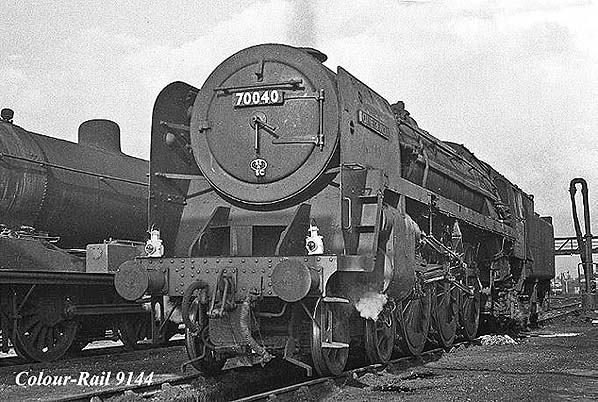
© Colour-Rail
Above is Britannia Pacific 70040 'Clive of India outside Cambridge shed on 16 October 1960. She was a Norwich (32A) locomotive at the time.
Today, the Liverpool Street - Cambridge route is termed the West Anglia Main Line (WAML) and this includes the the various branches. The WAML terminates at Cambridge and is now, discounting the Birmingham - Stansted Airport service, exclusively a London commuter route, the route north of Cambridge now being termed the Fen Line. As we saw back in Part 1, from the outset and until almost the end of British Rail things were rather different and apart from London - Cambridge local services the route was a main line connecting London with Norfolk. For almost a century-and-a-half Cambridge saw trains from Shoreditch/Bishopsgate / Liverpool Street to Norwich and then Great Yarmouth, King's Lynn and Hunstanton as these lines opened or were connected (Norwich trains from or via Cambridge originally terminated at Trowse). Over time these services were gradually withdrawn until the only trains from Liverpool Street to continue beyond Cambridge were those to Ely and King's Lynn. At one point it was no longer possible to travel by train between Cambridge and Norwich without changing at Ely but this service was reinstated following so-called privatisation. It is now an hourly DMU service between Cambridge and Norwich only, operated by whoever holds the franchise this week.
When the Riddles Crewe-built Britannia class was introduced, things were still 'old school' with trains from Liverpool Street serving a number of destinations north of Cambridge and it was decided to speed these services up.
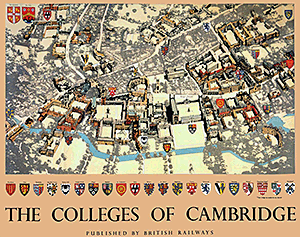 Popular with Eastern Region crews, the Britannias were detested on the Western Region other than at Cardiff Canton for some strange reason. The class soon developed problems with driving wheels shifting on axles and overheating crank bearings and they were withdrawn for modifications. This is thought to have been the reason for the second (1951/2) appearance of the Bulleid Pacifics on the Cambridge/Norwich services.
Popular with Eastern Region crews, the Britannias were detested on the Western Region other than at Cardiff Canton for some strange reason. The class soon developed problems with driving wheels shifting on axles and overheating crank bearings and they were withdrawn for modifications. This is thought to have been the reason for the second (1951/2) appearance of the Bulleid Pacifics on the Cambridge/Norwich services.
Problems overcome, the Britannias returned to Stratford and Norwich. The type enabled the Liverpool Street - Cambridge express runs to be speeded up to 60 - 64 minutes. These changes came in during 1953 although it was more of a token gesture with many trains being just as plodding as previously. Meanwhile, the Liverpool Street / Stratford - Cambridge stopping services continued to make do with with 4-6-0 types as well as the L1 2-6-4 tanks and, occasionally, N7 0-6-2 tanks.
The reign of the Britannias was not to be a long one as from 1958 the English Electric Type 4 diesels (later, Class 40) took over the longer distance services while the Brush Type 2 diesels (later, Classes 30 and 31) began to take over the King's Lynn - Liverpool Street and Cambridge - Liverpool Street services. The Britannias were later concentrated mainly on the London Midland Region with 70013 'Oliver Cromwell' surviving until the end of steam. She is one of two survivors from the class of 55, the other being 70000 'Britannia'. 'Clive of India', new in 1953, was withdrawn in April 1967 having served for a pathetic 14 years.
Of the other BR Standard types, the 8xxxx 2-6-4 tanks were frequent visitors to Cambridge from the Bedford line while a pair of 2MT 2-6-0 78xxx types appeared at Cambridge on services from Kettering, to which shed they had been allocated. The 9F 2-10-0s appeared on heavy goods trains while on 7 September 1955 92044 of that type appeared at Cambridge with a passenger train from the Liverpool Street line. It had been commandeered to take over from a defective locomotive at Bishop's Stortford.
You Can Have It In Any Colour So Long As It's.........
A part quote of Henry Ford, who ended his statement with the word 'black' when allegedly asked why his cars did not come in a range of colours. British Railways, fortunately, had other ideas but the road to uniformity was a long one as the image below shows.
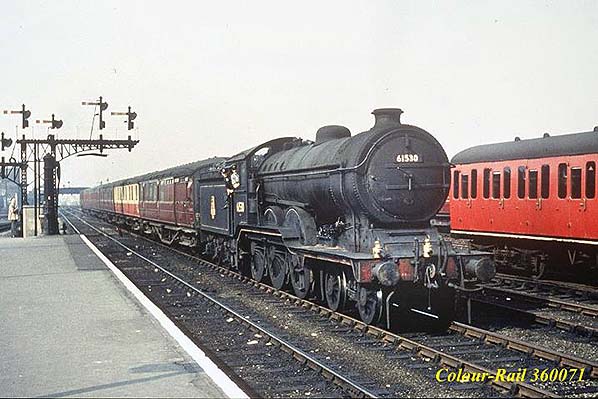
© Colour-Rail
Taken on 13 June 1959, this scene was typical of the time at Cambridge. The B12 locomotive is in the standard passenger lined black livery but still with the large version of the 'emaciated ferret' logo on the tender. The second coach is in carmine and cream livery, which was popularly also given slightly derogatory names such as 'blood and custard' or 'plum and spilt milk' or, worse, 'strawberries and vomit'! This livery appeared in 1950 as a result of a decision taken in 1949 on BR liveries. It sat well on the Gresley stock, less so on the BR Mk1 stock. It can be seen today on heritage railways but somehow never looks quite right. Other vehicles, above, are in the maroon livery introduced in 1956. The fifth vehicle might still be in the Eastern Region's painted teak livery, which was a disaster, but 1959 is really rather late for this. The maroon livery was durable and practical but, even with lining, was rather drab. Nevertheless it did sit fairly well on Thompson stock and the LMS-designed Stanier corridor stock. On the right is a BR Mk1 suburban coach in unlined crimson. It seems BR intended this livery for all suburban stock but in practice it was mainly, if not exclusively, applied to the locomotive-hauled stock. The King's Cross suburban stock eventually received lined maroon and then blue but did not survive long enough to receive blue / grey livery.
The Western Region of BR opted for a traditional chocolate and cream livery while the Southern Region went for a lacklustre green livery spruced up only by the use of yellow lettering and numbers. BR liveries is a complex subject for which a lengthy description cannot be justified in a feature primarily about Cambridge. For example, there were numerous shades of green and blue which even today are the subject of debate regarding names and to what they were applied.
The train in the above image is an empty stock working. The B12 carries the modified splasher design which was also applied to many of the Clauds. The result was a plainer but less antiquated appearance. By the time the photograph was taken, the B12s were approaching the end of their lives. 61530 had been one of the type fitted with ACFI feed water heater equipment during the 1930s. 13 June 1959 was a Saturday and 61530 is recorded as being transferred to Cambridge shed from Norwich during that week ending. Her time at Cambridge was brief as she was withdrawn in November of the same year after a working life of 45 years.
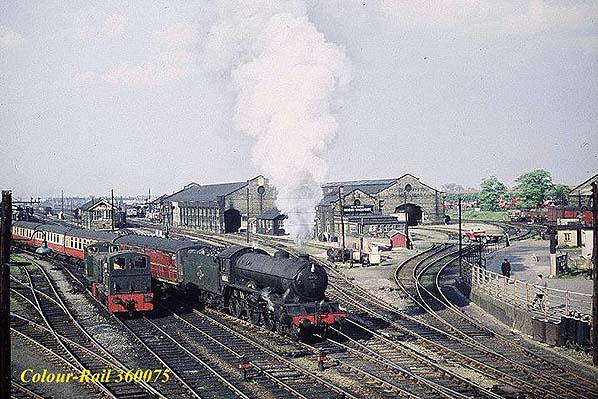
© Colour-Rail
A month or so before the B12 was photographed, one of the 'Footballer' Class B17s 61652 'Darlington' departs Cambridge on a southbound local service in May 1959. This time we can see a maroon Gresley brake-end and a mix of Gresley and BR Mk1 vehicles in carmine and cream. A pair of then-almost-new Class 03 diesel shunters are sitting having a natter. They are in original livery, BR locomotive green with red buffer beams. One is probably on south station pilot duty and the other on Coalfields sidings duty. We will be covering the diesels in detail shortly. On the right, the goods sheds do not appear to be very busy while a single rail fan sits on his bicycle beside the railings as a railway employee approaches, probably on his way home at the end of his shift. Note the BR lorry turning in across the tracks; at this time many BR road vehicles were painted maroon and cream and adorned with a plethora of numbers and lettering. The lorry is a four-wheeler, probably an Austin or a Commer. The little three-wheel Scammell Scarabs were also a common sight around Cambridge at this time. Maroon and cream suited these road vehicles and they always looked smart. Later, under NCL auspices (National Carriers Ltd.), a ghastly all-over yellow livery was applied.
The tender of 'Darlington' carries the post 1956 British Railways logo, sometimes known as the 'ferret and dartboard'. 'Darlington' had been a Cambridge locomotive since 1950 and remained there until withdrawn in September 1959.
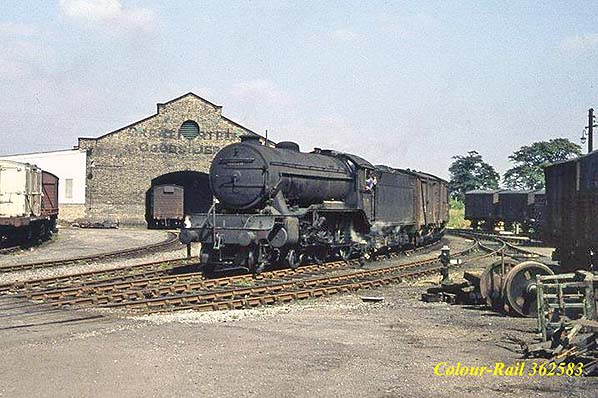
© Colour-Rail
For comparison with the previous image and still during 1959, August this time, we see Class K3 61880 creeping out of the up goods yard with a southbound van train. On the left is a BR insulated (hence white) container on a conflat wagon. These were the forerunners of Freightliner and an attempt to provide a door-to-door service with wagon-load traffic; containers going by rail for the bulk of their journeys and with collection from consignee and delivery to the customer's door being by road. The scheme was reasonably successful but the containers were really too small and wagon-load traffic, which in essence is what it was, was ultimately phased out. Redundant conflat wagons were later used as 'runners' for the smaller diesel shunters which could not be relied upon to operate track circuits on their own. These 'runners' became a familiar sight coupled to the Class 03 shunters at Cambridge and elsewhere.
On the right but out of view was the former GNR engine shed. By this time it was in use as a wagon repair shop, which explains the wagons visible on the right and the wheelset in the right foreground.
The K3s were intended as express goods locomotives but could also appear on passenger trains. They were rough riding and not popular with drivers. 61880 was Cambridge-based from February 1959 until December 1961 when she was transferred to March. She was withdrawn in September 1962 after a life of 33 years.
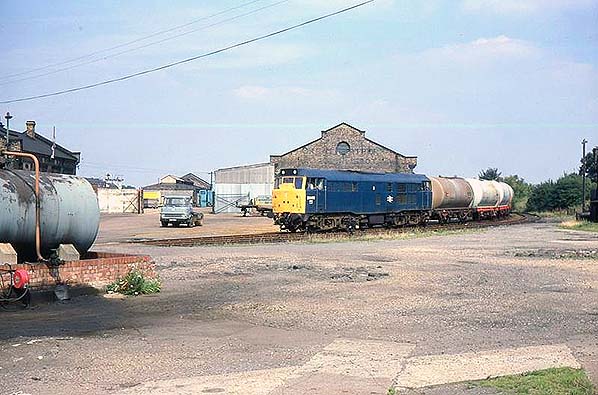
Photo by Chris Turnbull
Out of sequence, period wise, but convenient here for comparison is the above view taken in September 1980. By this time all that remained in respect of track was the roads exiting the up goods yard. There was still some road vehicle activity but very little goods was transferred to / from rail by this time. Rail tanker traffic was still a common sight, however. Oil terminals were located at Barnwell on the remnant of the Mildenhall branch and in the former LNWR goods yard. There was also the railway's own traffic for the diesel depot and so on. Tank traffic also operated to Ciba-Geigy, via their short-lived and then newly built spur near Duxford, as well to a handful of other locations to the south of Cambridge.
The Class 31 is in the later, tidier, BR blue livery. Earlier, many of the class were in a rather messy livery which had the BR logo and locomotive number duplicated on both sides of each cab. Others had the logo on both sides of each cab and the number behind each cab door - an equally messy arrangement. The livery seen above had the number on the drivers side of each cab, in other words diagonally across the locomotive. On the other side, the BR logo would be nearer to 2 end; on the side visible above it was closer to 1 end. Headcode displays had been abolished. Headcodes were - and still are - used but with the introduction of power signal boxes and modern communications, displaying them on locomotives was no longer necessary.
As this part covers the steam era at Cambridge it would be inappropriate to end with an image of a diesel and a blue diesel at that so.......
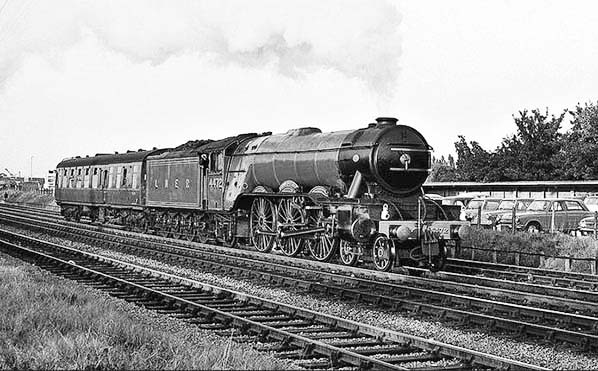
© Chris Burton
.......above is by-then-preserved 'Flying Scotsman', sole survivor of the A3 class just south of Hills Road bridge on 1 October 1964. This was 1Z61, a Doncaster - King's Cross positioning move which had run via the Joint Line, March and Ely. 'Flying Scotsman' was to operate the Ian Allan 'Darlington Marquess' railtour on 3 October which operated from King's Cross via Harrogate and Ripon; a route not now possible. The tour also involved K4 3442 'The Great Marquess' and K1 62041.
At the time of the above photograph, steam was still appearing at Cambridge on odd occasions from the Bletchley line which is out of sight behind the photographer. 'Flying Scotsman' appeared at Cambridge on a number of occasions until being sent to the USA in 1968; this was the infamous tour which bankrupted the locomotive's then owner, Alan Pegler. The circumstances of this of are not widely known outside of railway circles; the USA tour had been allowed funding by Harold Wilson's Labour government on the basis of the tour being a trade mission. When Labour was replaced by Edward Heath's Conservative government in 1970 the funding was withdrawn. Pegler, however, decided to go ahead regardless with a second tour in 1970 (the locomotive remained in the USA in the interim) but with no government funding Pegler was bankrupted and very much in debt. Pegler then had to work his passage home onboard a cruise ship, leaving 'Flying Scotsman' impounded in a US Army base to keep it safe from creditors. The locomotive was eventually returned home thanks to the intervention of Sir William McAlpine, as he is now titled. Sir William has his own private railway on his Fawley estate in Buckinghamshire which includes the former Somersham station from the St Ives - March line which had closed in 1967.
The Breakdown Train
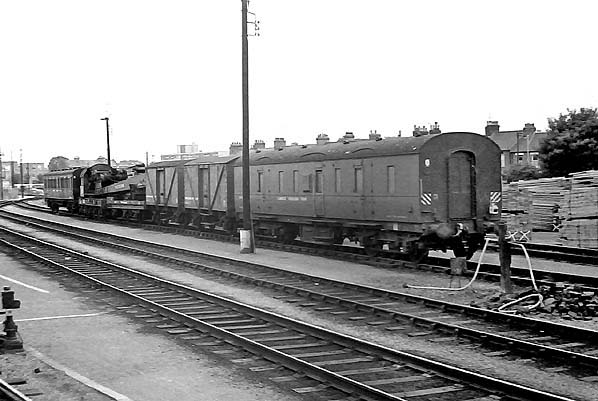
Photo by Alan Brown
The breakdown train is perhaps most appropriate in Part 5 as it was steam powered. At one time a breakdown train could be found at any depot of importance; for example, within a 50 or so mile radius of Cambridge such trains could be found at Stratford, Finsbury Park, March, New England (Peterborough), Bletchley and so on. These trains not only attended derailments but could also be seen undertaking other work such as lifting signal gantries, bridge decks and so forth. Lifting capacity varied greatly and the cranes came from a variety of manufacturers, the most well known being Cowans Sheldon, Ransomes & Rapier and Craven Brothers. Some railway companies, including the GER, built their own. Cranes were kept in light steam but raised to working pressure while on the way to wherever they were needed. In the days of steam traction this practice was fine but following the end of steam, men and facilities capable of handling steam boilers gradually became thin on the ground and the expense of keeping cranes in steam came to be viewed as a problem. As a result, many were converted to diesel-hydraulic but nevertheless steam cranes could still be found on BR towards the end of the 20th century. Today many former BR cranes, some steam, can be seen on heritage railways and many are in working order. The modern railway generally hires-in specialist road cranes when the need arises but some rail cranes can still be seen, such as those operated by Colas Rail.
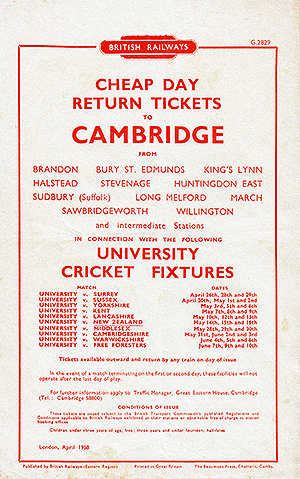 The above image shows Cambridge breakdown train in January 1970 and at its usual spot on 'The Dump'. The crane is Cowans Sheldon 45-ton 133 (DE 330133), new to the LNER in 1940 and numbered 961606 in the LNER series. It had replaced Ransomes & Rapier 35 ton crane 131 (DE 330131) which moved to Stratford. 133 was the crane used by Hornby-Dublo as the basis for their 4mm scale model and was also the crane which attended the Soham munitions train explosion in 1944. Further, it was the crane sent to Bartlow in 1968 to 'arrange' the train used in The Virgin Soldiers film. In 1987 133, by then no longer at Cambridge, was converted to diesel-hydraulic and renumbered ADRC 95219. It was scrapped in 1994.
The above image shows Cambridge breakdown train in January 1970 and at its usual spot on 'The Dump'. The crane is Cowans Sheldon 45-ton 133 (DE 330133), new to the LNER in 1940 and numbered 961606 in the LNER series. It had replaced Ransomes & Rapier 35 ton crane 131 (DE 330131) which moved to Stratford. 133 was the crane used by Hornby-Dublo as the basis for their 4mm scale model and was also the crane which attended the Soham munitions train explosion in 1944. Further, it was the crane sent to Bartlow in 1968 to 'arrange' the train used in The Virgin Soldiers film. In 1987 133, by then no longer at Cambridge, was converted to diesel-hydraulic and renumbered ADRC 95219. It was scrapped in 1994.
The rest of the train consists of what appears to be an ex-GER bogie coach in use as a mess and riding van (at the far end) which had replaced an equally antiquated clerestory coach, a pair of former 'insulfish' (insulated fish) vans and an LMS-designed Stanier period III full brake. The latter had at some point replaced an ex-LNER Gresley coach. The flat wagon between crane and insulfish vans is the jib carrier and for all intents and purposes was part of the crane. Livery of the train was by this time red; LNER cranes were originally black and with the advent of BR carried the early lion and wheel logo.
The Stanier full brakes remained a common sight, still performing their intended purpose, long after all pre-nationalisation passenger-carrying stock had been withdrawn, as did the 6-wheel 'stove' vans and a number of ex-Southern Railway vans.
Tickets from Michael Stewart. Cricket handbill from Darren Kitson - click here to see a larger version of the four handbills in Part 5.



 The N7s were a Hill design for Great Eastern Railway London suburban services. Some were fitted with condensing gear but this was later removed by the LNER. The nature of their work required dictated frequent stopping and starting with good acceleration and braking characteristics. The class thus had relatively small 4ft 10in driving wheels and this, when viewing the locomotives from certain angles, gave them a rather odd, dumpy appearance. On the Saffron Walden branch they replaced the ex-North Eastern G5 0-4-4 tanks which had moved to Cambridge from the Palace Gates branch.
The N7s were a Hill design for Great Eastern Railway London suburban services. Some were fitted with condensing gear but this was later removed by the LNER. The nature of their work required dictated frequent stopping and starting with good acceleration and braking characteristics. The class thus had relatively small 4ft 10in driving wheels and this, when viewing the locomotives from certain angles, gave them a rather odd, dumpy appearance. On the Saffron Walden branch they replaced the ex-North Eastern G5 0-4-4 tanks which had moved to Cambridge from the Palace Gates branch.
 Nothing whatsoever to do with the 1948 locomotive exchanges, in 1949 and again in 1951/2 a number of ex-Southern Railway Bulleid Light Pacifics appeared on what had come to be known as BR Eastern Region's Great Eastern Section (GE), based at Stratford. The reason for this is not entirely clear to this day but there are suspicions; the 1949 trial may have been to test a Pacific type (4-6-2) on the GE ahead of plans to accelerate Liverpool Street - Norwich trains via both Ipswich and Cambridge, while the 1951/2 appearance was probably due to problems with the then newly introduced Britannia Pacifics.
Nothing whatsoever to do with the 1948 locomotive exchanges, in 1949 and again in 1951/2 a number of ex-Southern Railway Bulleid Light Pacifics appeared on what had come to be known as BR Eastern Region's Great Eastern Section (GE), based at Stratford. The reason for this is not entirely clear to this day but there are suspicions; the 1949 trial may have been to test a Pacific type (4-6-2) on the GE ahead of plans to accelerate Liverpool Street - Norwich trains via both Ipswich and Cambridge, while the 1951/2 appearance was probably due to problems with the then newly introduced Britannia Pacifics.

 However, at Cambridge the two-speed design of the Y3s was useful when running light or transferring a wagon or two between Chesterton Junction and the engineers siding near Mill Road which involved a run of a couple of miles along the main line.
However, at Cambridge the two-speed design of the Y3s was useful when running light or transferring a wagon or two between Chesterton Junction and the engineers siding near Mill Road which involved a run of a couple of miles along the main line.
 There was a need to replace many worn out and inefficient steam locomotives following WWII and with the railways nationalised in 1948 it made good sense to have some sort of standard fleet. BR was also faced with a labour problem; men were beginning to find cleaner and better paid work in other areas of industry and which did not, to a degree, involve the antisocial hours that railway work did. Today it is hard to visualise the life of the would-be train driver of bygone times. A young recruit of the steam era would be required to start as a cleaner and this involved the filth, grime and a degree of danger within the confines of steam sheds. Eventually the recruit might make the grade of passed cleaner, meaning he was still a cleaner but could act as locomotive fireman when required. The next step up was fireman, then passed fireman which meant he could drive when required to do so. The next step up was to driver but that in itself was not necessarily glamourous; as fireman, he might be working on main line 'top link' jobs but when promoted to driver he may very well find himself back on more mundane goods and local traffic. Depending upon which shed was involved, being promoted to a 'top link' driver took many years and in some cases career railwaymen did not acquire senior status until shortly before retirement. It was for this reason that senior drivers of days gone commanded a justified degree of respect and their knowledge and experience was impossible to describe in any book or film.
There was a need to replace many worn out and inefficient steam locomotives following WWII and with the railways nationalised in 1948 it made good sense to have some sort of standard fleet. BR was also faced with a labour problem; men were beginning to find cleaner and better paid work in other areas of industry and which did not, to a degree, involve the antisocial hours that railway work did. Today it is hard to visualise the life of the would-be train driver of bygone times. A young recruit of the steam era would be required to start as a cleaner and this involved the filth, grime and a degree of danger within the confines of steam sheds. Eventually the recruit might make the grade of passed cleaner, meaning he was still a cleaner but could act as locomotive fireman when required. The next step up was fireman, then passed fireman which meant he could drive when required to do so. The next step up was to driver but that in itself was not necessarily glamourous; as fireman, he might be working on main line 'top link' jobs but when promoted to driver he may very well find himself back on more mundane goods and local traffic. Depending upon which shed was involved, being promoted to a 'top link' driver took many years and in some cases career railwaymen did not acquire senior status until shortly before retirement. It was for this reason that senior drivers of days gone commanded a justified degree of respect and their knowledge and experience was impossible to describe in any book or film.

 Popular with Eastern Region crews, the Britannias were detested on the Western Region other than at Cardiff Canton for some strange reason. The class soon developed problems with driving wheels shifting on axles and overheating crank bearings and they were withdrawn for modifications. This is thought to have been the reason for the second (1951/2) appearance of the Bulleid Pacifics on the Cambridge/Norwich services.
Popular with Eastern Region crews, the Britannias were detested on the Western Region other than at Cardiff Canton for some strange reason. The class soon developed problems with driving wheels shifting on axles and overheating crank bearings and they were withdrawn for modifications. This is thought to have been the reason for the second (1951/2) appearance of the Bulleid Pacifics on the Cambridge/Norwich services. 





 The above image shows Cambridge breakdown train in January 1970 and at its usual spot on 'The Dump'. The crane is Cowans Sheldon 45-ton 133 (DE 330133), new to the LNER in 1940 and numbered 961606 in the LNER series. It had replaced Ransomes & Rapier 35 ton crane 131 (DE 330131) which moved to Stratford. 133 was the crane used by Hornby-Dublo as the basis for their 4mm scale model and was also the crane which attended the Soham munitions train explosion in 1944. Further, it was the crane sent to Bartlow in 1968 to 'arrange' the train used in The Virgin Soldiers film. In 1987 133, by then no longer at Cambridge, was converted to diesel-hydraulic and renumbered ADRC 95219. It was scrapped in 1994.
The above image shows Cambridge breakdown train in January 1970 and at its usual spot on 'The Dump'. The crane is Cowans Sheldon 45-ton 133 (DE 330133), new to the LNER in 1940 and numbered 961606 in the LNER series. It had replaced Ransomes & Rapier 35 ton crane 131 (DE 330131) which moved to Stratford. 133 was the crane used by Hornby-Dublo as the basis for their 4mm scale model and was also the crane which attended the Soham munitions train explosion in 1944. Further, it was the crane sent to Bartlow in 1968 to 'arrange' the train used in The Virgin Soldiers film. In 1987 133, by then no longer at Cambridge, was converted to diesel-hydraulic and renumbered ADRC 95219. It was scrapped in 1994.
 Home Page
Home Page